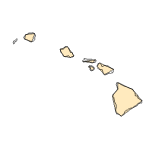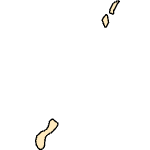Caulerpa prolifera
Algae
Native Transplant |
|
Synonyms and Other Names: Fucus prolifer (Forsskål, 1775)
Caulerpa ocellata (Lamouroux, 1809)
Caulerpa ollivieri (Dostál, 1929)
Taxonomy: available through
www.itis.gov
Identification: Caulerpa prolifera (family Caulerpaceae) is a species of green algae. Fronds can be bright green but also dark/olive green, upright, elongated ovular, flat (thallus resembling leaf), and entire margins (undivided). Fronds are variable in length, shape, and color based on light conditions. The blade is tapered where it connects to the stalk. The blades are connected underground by stolons (runners) that attach to the substrate through rhizoids (roots).
Commonly misidentified as Caulerpa taxifolia, but C. taxifolia has divided fronds.
Caulerpa species identification key
Size: frond: 6-15 cm tall, stipe: 1-2 cm tall (stolons can be > 1 m long)
Native Range: Native to the tropical western and eastern Atlantic Ocean extending to the Mediterranean Sea and Indo-Pacific Ocean. In North America, Caulerpa prolifera can be found in its native range in North Carolina, Florida, and Mexico (Taylor 1960). First occurrences in Texas were documented in 1988 (Strenth 2001).



|

Alaska |

Hawaii |

Puerto Rico &
Virgin Islands |

Guam Saipan |
Hydrologic Unit Codes (HUCs) Explained
Interactive maps: Point Distribution Maps
Nonindigenous Occurrences:
Globally, Caulerpa prolifera can be found in Europe, the Mediterranean Basin, the Caribbean Basin, West Africa, Eastern South America, and Southeast Asia (Guiry and Guiry 2023). Caulerpa prolifera was found in 2021 in China Cove, Newport Bay, California. Another population was discovered in 2023 at Coronado Cays in San Diego Bay.
Table 1. States with nonindigenous occurrences, the earliest and latest observations in each state, and the tally and names of HUCs with observations†. Names and dates are hyperlinked to their relevant specimen records. The list of references for all nonindigenous occurrences of Caulerpa prolifera are found here.
Table last updated 12/14/2025
† Populations may not be currently present.
Ecology: Caulerpa prolifera produces fast growing adhesive rhizoids that attach to surfaces like rocks, gravel, sand, and mud (Terrados and Ros 1991; Friedlander et al. 2006). This species can spread through fragmentation by rapid formation of thalli (Terrados and Ros 1991; Silva 2003). A study found C. prolifera can grow rhizomes at a rate of 2 to 8 mm/day and produce a new cluster of rhizoids every day (Chen and Jacobs 1966). It grows best in salinities ranging from 36-47 ppt, mud substrate, and temperatures ranging from 10°C – 35°C (Terrados and Ros 1991). Caulerpa prolifera can photosynthesize in low light environments better than other species of macroalgae (Terrados and Ros 1992). Populations in the Canary Islands can grow at depths of 3 - 50 m; at 15 m, C. prolifera spread was limited by grazing by predators (Johnston 1969). It is limited by nitrogen in temperate terrigenous sediments and phosphorous limited in tropical carbonate sediments (Erhan et al. 2022). Unlike sea grasses, this macroalgae's rhizoids can uptake nutrients from sediment porewater (Tuya et al. 2012).
Means of Introduction: It is speculated that Caulerpa prolifera was introduced to the western United States from the aquarium trade. It is believed it was introduced to California through aquarium dumping, a practice that is illegal in California.
Status: Eradication efforts are ongoing as of 2023 in Newport Bay and San Diego Bay, California (CDFA 2023).
Impact of Introduction: Summary of species impacts derived from literature review. Click on an icon to find out more...
Caulerpa prolifera is a fast-growing species of macroalgae. This fast growth and ability to colonize unvegetated substrate allows C. prolifera to out-compete species of sea grasses and macroalgae (Parreira et al. 2021; Terrados and Ros 1991). It was shown to release a toxin that prevents herbivory from native species in its introduced range and in turn displaces wildlife due to habitat loss and food reduction (California Water Boards 2018).
Eradication efforts for a congener, Caulerpa taxifolia, from Agua Hedionda Lagoon and Huntington Harbor, California took approximately 7 years and cost $7,000,000 USD (Gillies 2013).
References: (click for full references)
California Department of Food and Agriculture, Fisheries Branch (CDFA). 2023. Invasive Algae –
Caulerpa prolifera. https://wildlife.ca.gov/Conservation/Invasives/Species/Caulerpa. Accessed on 10/18/2023.
California Water Boards. 2018. Killer algae: killer algae found in Southern California. https://www.waterboards.ca.gov/losangeles/water_issues/programs/water_quality_issues/killer_algae_article.shtml. Created on 08/23/2018. Accessed on 10/17/2023.
Chen, J.C.W. and W.P. Jacobs. 1966. Quantitative study of development of the giant coenocyte, Caulerpa prolifera. American Journal of Botany 53(5):413-520. https://doi.org/10.1002/j.1537-2197.1966.tb07354.x.
Cimino, G., and M.T. Ghiselin. 1998. Chemical defense and evolution in the Sacoglossa (Mollusca: Gastropoda: Opisthobranchia). Chemoecology 8:51-60.
Erhan, M., C. Olguner, M. Gokoglu, and Y. Ozvarol. 2022. Population dynamics and ecology of Caulerpa prolifera vs Caulerpa taxifolia var. distichophylla within a Levantine Gulf. Thalassas 38(2):1311-1325. https://doi.org/10.1007/s41208-022-00477-7.
Friedlander, M., Y. Kosov, G. Keret, and C. Dowes. 2006. Production of rhizoids by Caulerpa prolifera in culture. Aquatic Botany 85(3):263-266. https://doi.org/10.1016/j.aquabot.2006.06.004.
Frisch, S.M. 2003. Taxonomic diversity, geographic distribution, and commercial availability of aquarium-traded species of Caulerpa (Chlorophyta Caulerpaceae) in southern California, USA. Unpublished M.S. thesis. California State University, Fullerton, CA.
Gillies, A. 2023. California passes legislation banning invasive genus of ocean algae. News Channel 3-12. California. https://keyt.com/news/environment/2023/07/31/california-passes-legislation-banning-invasive-genus-of-ocean-algae/. Created on 07/31/2023. Accessed on 10/17/2023.
Guiry, M.D., and Guiry, G.M. 2023. AlgaeBase. World Wide Web electronic publication, National University of Ireland, Galway. https://www.algaebase.org/search/species/detail/?species_id=355&sk=0&from=results. Created on 03/08/2023. Accessed on 10/17/2023.
Johnston, C.S. 1969. The ecological distribution and primary production of the macrophytic marine algae in the Eastern Canaries. Internationale Revue der gesamten Hydrobiologie und Hydrographie 54(4):473-640. https://doi.org/10.1002/iroh.19690540402.
Parreira, F., B. Martinez-Crego, C.M.L. Afonso, M. Machado, F. Oliveira, J.M. dos Santos Goncalves, and R. Santos. 2021. Biodiversity consequences of Caulerpa prolifera takeover of a coastal lagoon. Estuarine Coastal Shelf Science 255:107344. https://doi.org/10.1016/j.ecss.2021.107344.
Silva, P.C. 2003. Historical overview of the genus Caulerpa. Cryptogamie Algologie 24(1):33-50.
Smith, C.M. and L.J. Walters. 1999. Fragmentation as a strategy for Caulerpa species: fates of fragments and implications for management of an invasive weed. Marine Ecology 20(3-4):197-372. https://doi.org/10.1046/j.1439-0485.1999.2034079.x.
Strenth, N.E. 2001. Caulerpa prolifera (Chlorophyta: Caulerpaceae) from the Laguna Madre of South Texas. Texas Journal of Science 53(2):187-189.
Taylor, W.R. 1960. Marine algae of the eastern tropical and subtropical coasts of the Americas. University of Michigan Press, Ann Arbor, MI.
Terrados, J. and J. Ross. 1991. Production dynamics in a macrophyte-dominated ecosystem: the Mar Menor coastal lagoon (SE Spain). Oecologia aquatica 10:255-270.
Terrados, J. and J.D. Ross. 1992. The influence of temperature on seasonal variation of Caulerpa prolifera (Forsskal) Lamouroux photosynthesis and respiration. Journal of Experimental Marine Biology and Ecology 162(2):199-212. https://doi.org/10.1016/0022-0981(92)90201-K.
Thibaut, T. and A. Meinesz. 2000. Are the Mediterranean ascoglossan molluscs Oxynoe olivacea and Lobiger serradifalci suitable agents for a biological control against the invading tropical alga Caulerpa taxifolia? Comptes Rendus de l'Academie des Sciences - Series III - Sciences de la Vie 323(5):477-488. https://doi.org/10.1016/S0764-4469(00)00151-7.
Tuya, F., H. Hernandez-Zerpa, F. Espino, and R. Haroun. 2012. Drastic decadal decline of the seagrass Cymodocea nodosa at Gran Canaria (eastern Atlantic): interactions with the green algae Caulerpa prolifera. Aquatic Botany 105:1-6. https://doi.org/10.1016/j.aquabot.2012.10.006.
Other Resources:
Mooney, R. 2022.
Caulerpa prolifera removal, eDNA data collection, and fragment transport data collection at Collins Isle, Newport Beach, California. Marine Taxonomic Services, Ltd, San Marcos, CA. https://marinetaxonomicservices.com/.
Southern California Caulerpa Action Team. 2021. Rapid Response and Eradication Plan for the Invasive Green Alga Caulerpa prolifera in Newport Bay. California Department of Fish and Wildlife. https://nrmsecure.dfg.ca.gov/FileHandler.ashx?DocumentID=193375.
Author:
Jordon, A., and I. Pfingsten
Revision Date: 12/5/2023
Peer Review Date: 12/5/2023
Peer Reviewed By: Miller, W. (U.S. Fish and Wildlife Service); Bedinger, L. (Cherokee Nation System Solution)
Citation Information:
Jordon, A., and I. Pfingsten, 2025, Caulerpa prolifera (P. Forsskål) J.V. Lamouroux: U.S. Geological Survey, Nonindigenous Aquatic Species Database, Gainesville, FL, https://nas.er.usgs.gov/queries/FactSheet.aspx?SpeciesID=3871, Revision Date: 12/5/2023, Peer Review Date: 12/5/2023, Access Date: 12/14/2025
This information is preliminary or provisional and is subject to revision. It is being provided to meet the need for timely best science. The information has not received final approval by the U.S. Geological Survey (USGS) and is provided on the condition that neither the USGS nor the U.S. Government shall be held liable for any damages resulting from the authorized or unauthorized use of the information.